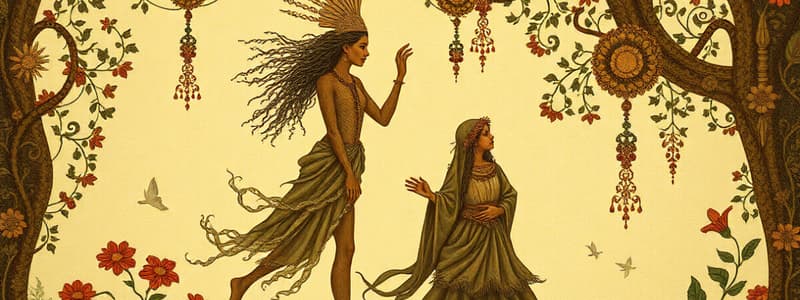Podcast
Questions and Answers
What significant trait distinguishes humans from other primates regarding manual capabilities?
What significant trait distinguishes humans from other primates regarding manual capabilities?
- The ability to swim efficiently
- Having curved fingers for better grip
- Possessing webbed fingers for better swimming
- The ability to oppose the thumb with other fingers (correct)
Which of the following subspecies of Homo Sapiens was discovered in a cave in France?
Which of the following subspecies of Homo Sapiens was discovered in a cave in France?
- Homo Habilis
- Cro-Magnon Man (correct)
- Neanderthal Man
- Homo Erectus
What primary biological feature allowed humans to create complex survival skills?
What primary biological feature allowed humans to create complex survival skills?
- Developed brain capable of advanced functioning (correct)
- Slower metabolism for better energy conservation
- Color vision that exceeds other species
- Longer limbs than other primates
Which activity did both Neanderthal Man and Cro-Magnon Man engage in?
Which activity did both Neanderthal Man and Cro-Magnon Man engage in?
The capacity to perform a precision grip is primarily due to what characteristic of the human hand?
The capacity to perform a precision grip is primarily due to what characteristic of the human hand?
What type of grip allows humans to hold objects firmly, crucial for activities such as hunting?
What type of grip allows humans to hold objects firmly, crucial for activities such as hunting?
What was a notable artistic contribution of Cro-Magnon Man?
What was a notable artistic contribution of Cro-Magnon Man?
Which characteristic of human hands aids in both power and precision grip?
Which characteristic of human hands aids in both power and precision grip?
What is the definition of culture?
What is the definition of culture?
What best describes the relationship between evolution and culture?
What best describes the relationship between evolution and culture?
Which of the following species is recognized as the first true human?
Which of the following species is recognized as the first true human?
What is the significance of Homo Erectus in human evolution?
What is the significance of Homo Erectus in human evolution?
Which fossil is associated with Homo Erectus?
Which fossil is associated with Homo Erectus?
How do scientists generally categorize the early human species?
How do scientists generally categorize the early human species?
What role does cultural adaptation play in human society?
What role does cultural adaptation play in human society?
What is a characteristic feature of the species known as Homo Habilis?
What is a characteristic feature of the species known as Homo Habilis?
Flashcards are hidden until you start studying
Study Notes
Definition and Importance of Culture
- Culture encompasses beliefs, practices, values, attitudes, laws, norms, artifacts, symbols, and knowledge shared within a society.
- It arises as humans seek to survive and adapt to their environments, addressing biological limitations.
Evolution and Biological Changes
- Human evolution is a protracted journey focused on survival against environmental challenges and competing species.
- Biocultural evolution highlights the interplay between biological development and cultural advancements in humans.
- Around 15 to 20 distinct species of early humans are recognized, though their relationships and classifications remain debated.
Species Characteristics
- Hominids: “Manlike primates” emerged about 40 million years ago, including species like Ramapithecus and Australopithecus.
- Homo Habilis: Known as "Handy Man," this species lived 2.4 to 1.4 million years ago and was the first to use stone tools.
- Homo Erectus: "The Upright Man," existing around 500,000 years ago, made advanced tools and walked upright; significant fossils include "Java Man" and "Peking Man."
- Homo Sapiens: "The Thinking Man," believed to have descended directly from earlier species 250,000 years ago, engaged in hunting, fishing, and agriculture, and exhibited burial rituals and religious practices. Key subspecies include:
- Neanderthal Man: Resided in Europe and relied on hunting and fishing.
- Cro-Magnon Man: Early artists known for cave paintings and crafted decorative tools.
Biological Capacities for Cultural Development
- Thinking Capacity: Human brains weigh approximately 1.4 kg and are more complex than those of other primates, facilitating advanced survival skills and cultural creativity.
- Gripping Capacity: Unique human hands feature opposable thumbs allowing for power and precision grips, essential for tool use and crafting:
- Power Grip: Enables firm holding of tools for hunting.
- Precision Grip: Facilitates careful manipulation of objects, enhancing task performance.
Studying That Suits You
Use AI to generate personalized quizzes and flashcards to suit your learning preferences.




